Fuse assembly
Urrea , et al.
U.S. patent number 10,283,916 [Application Number 14/157,188] was granted by the patent office on 2019-05-07 for fuse assembly. This patent grant is currently assigned to LITTELFUSE, INC.. The grantee listed for this patent is Littelfuse, Inc.. Invention is credited to Gary M. Bold, Julio Urrea.
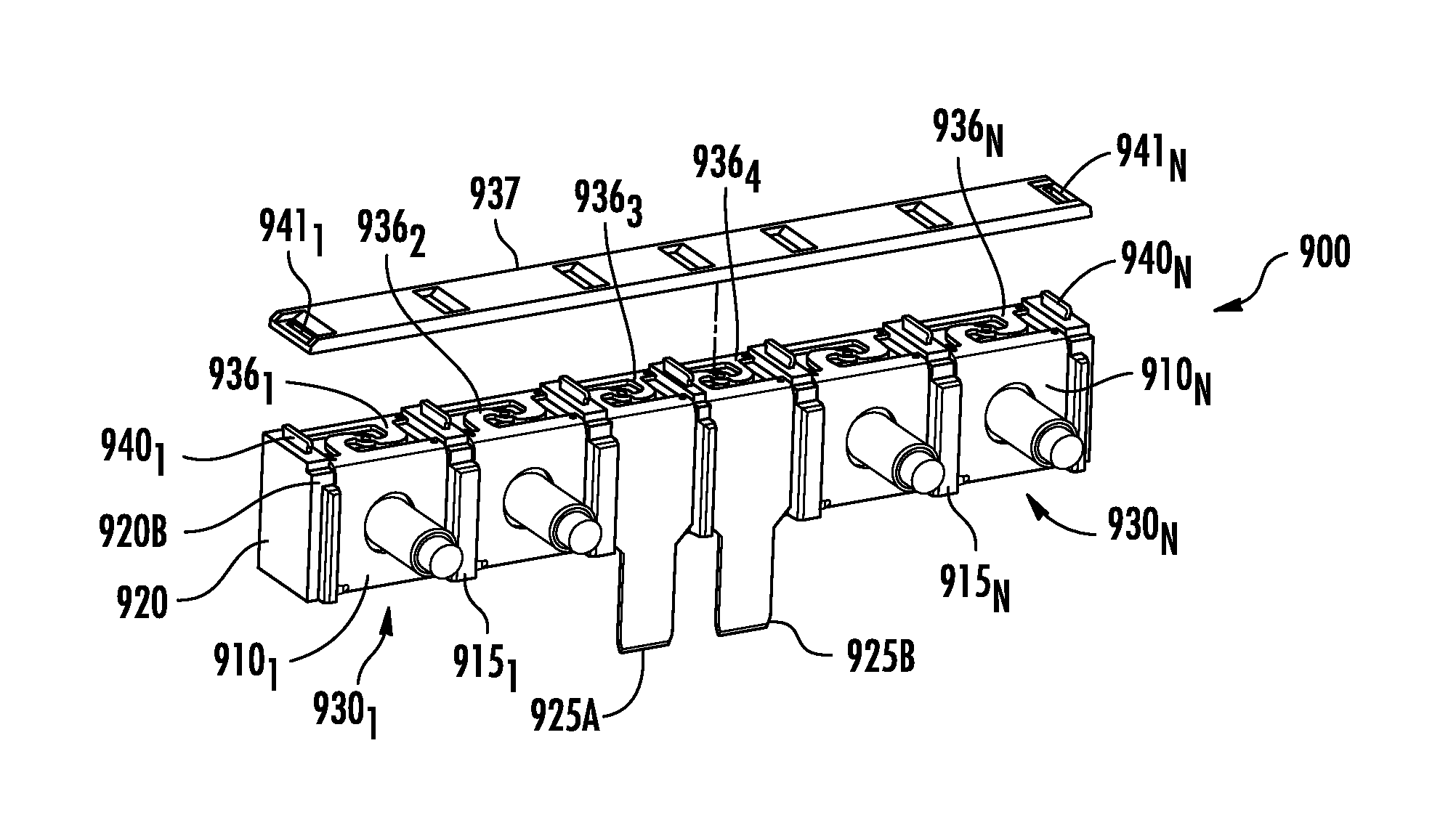





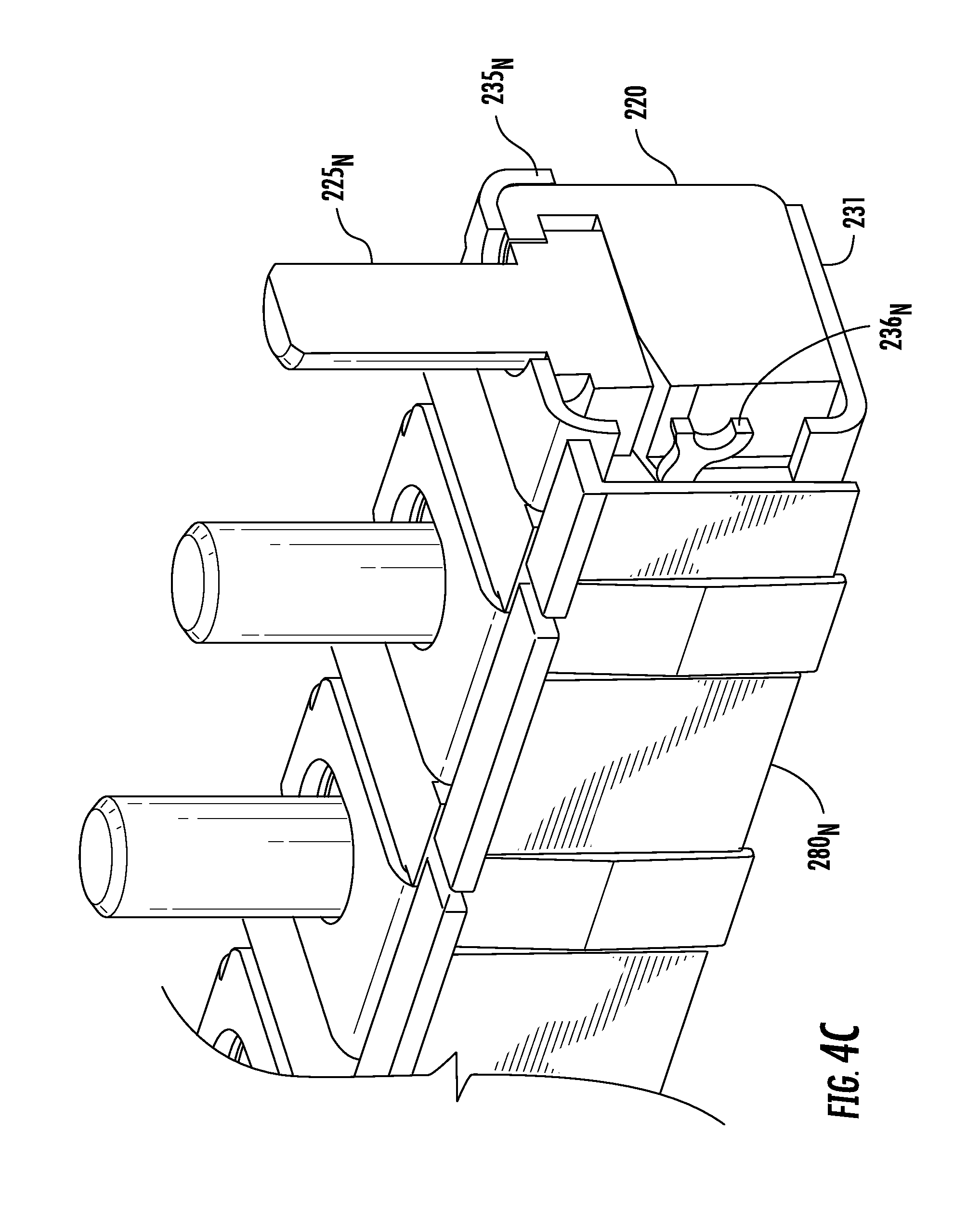
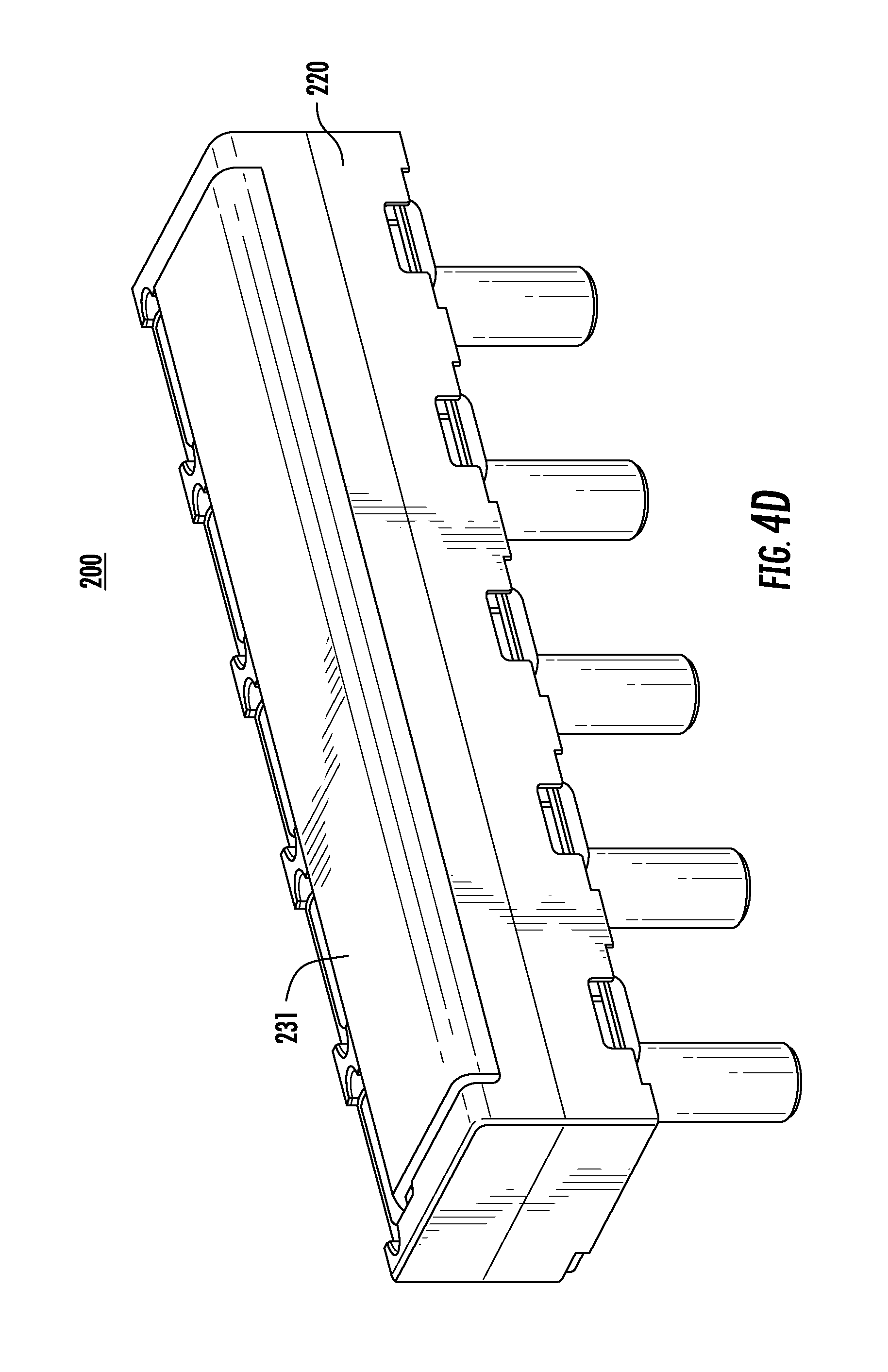
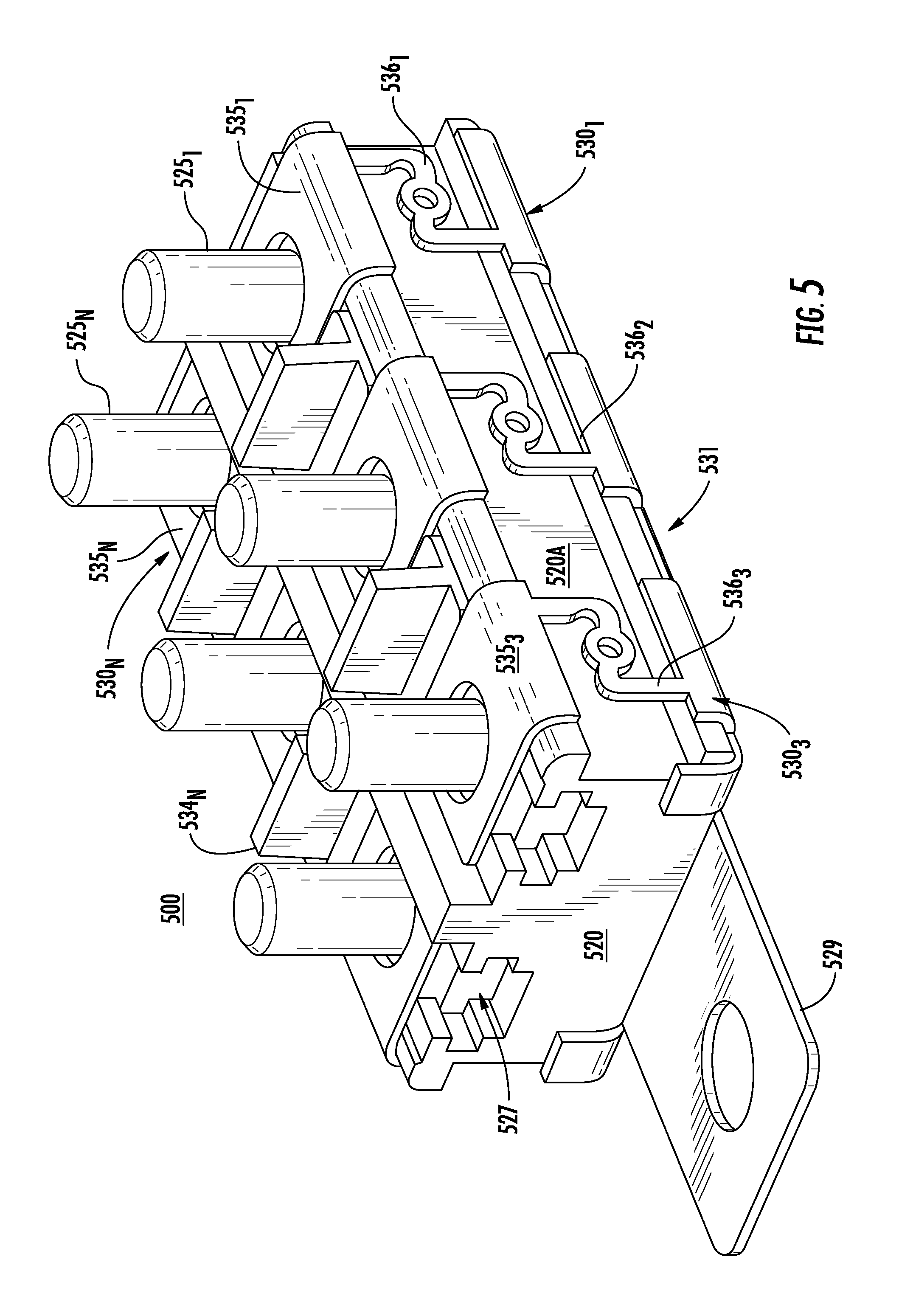

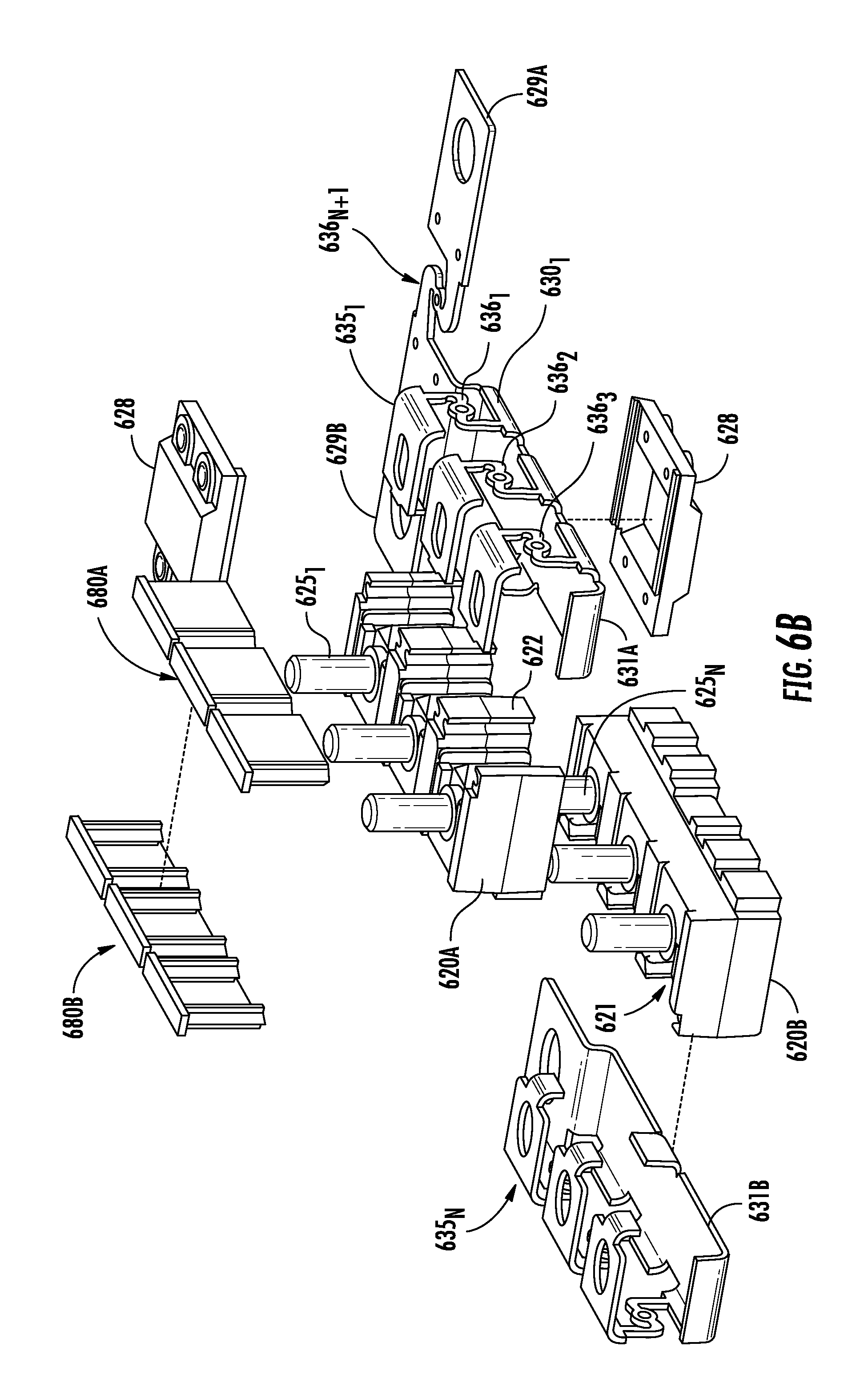
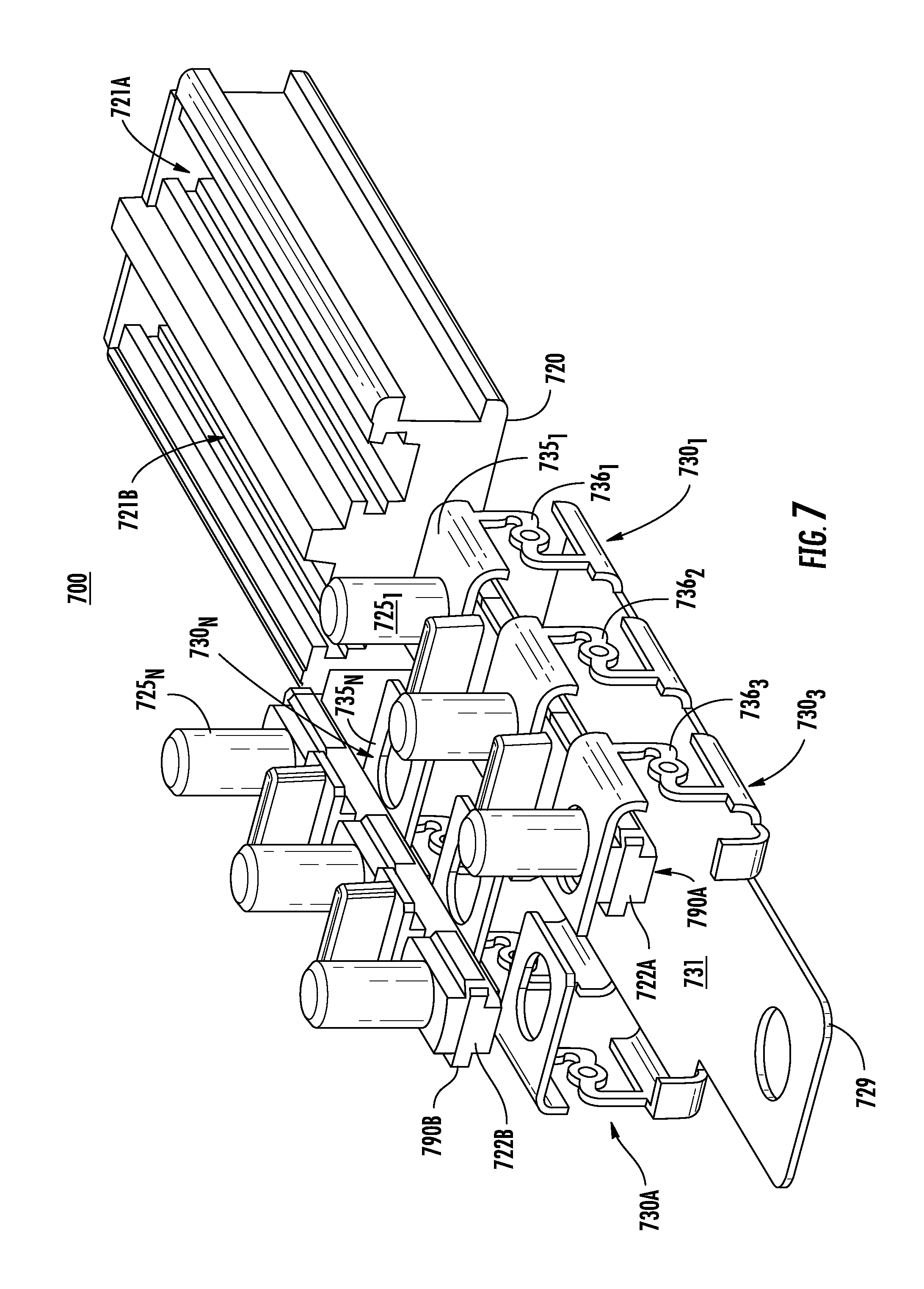
View All Diagrams
| United States Patent | 10,283,916 |
| Urrea , et al. | May 7, 2019 |
Fuse assembly
Abstract
A circuit protection assembly includes a mounting block, a unitary fuse assembly, a post assembly and a plug connector. The unitary fuse assembly is disposed the mounting block and includes a plurality of fuses each of which is defined by a portion of a bus plate disposed on the lower surface of the mounting block to form a first terminal of the fuse, a second terminal disposed at least partially on the upper surface of the mounting block and a fuse element connecting the first terminal and the second terminal. The post assembly is disposed at least partially within the mounting block and a post extending from the block. The plug connector extends from a portion of the first terminal of at least one of the plurality of fuses.
| Inventors: | Urrea; Julio (Chicago, IL), Bold; Gary M. (Palatine, IL) | ||||||||||
|---|---|---|---|---|---|---|---|---|---|---|---|
| Applicant: |
|
||||||||||
| Assignee: | LITTELFUSE, INC. (Chicago,
IL) |
||||||||||
| Family ID: | 47883634 | ||||||||||
| Appl. No.: | 14/157,188 | ||||||||||
| Filed: | January 16, 2014 |
Prior Publication Data
| Document Identifier | Publication Date | |
|---|---|---|
| US 20140134881 A1 | May 15, 2014 | |
Related U.S. Patent Documents
| Application Number | Filing Date | Patent Number | Issue Date | ||
|---|---|---|---|---|---|
| 13230278 | Sep 12, 2011 | 8665056 | |||
| 13109831 | May 17, 2011 | 8669840 | |||
| 61345840 | May 18, 2010 | ||||
| 61409837 | Nov 3, 2010 | ||||
| Current U.S. Class: | 1/1 |
| Current CPC Class: | H01H 85/205 (20130101); H01H 85/12 (20130101); H01H 85/044 (20130101); H01R 13/68 (20130101); H01H 2085/025 (20130101); H01H 2085/0555 (20130101) |
| Current International Class: | H01R 13/68 (20110101); H01H 85/044 (20060101); H01H 85/12 (20060101); H01H 85/20 (20060101); H01H 85/02 (20060101); H01H 85/055 (20060101) |
| Field of Search: | ;337/188-189,191,227,256 ;439/620.27 |
References Cited [Referenced By]
U.S. Patent Documents
| 3323021 | May 1967 | Sever |
| 3969695 | July 1976 | Belcher |
| 4344060 | August 1982 | Ciesemier |
| 5451170 | September 1995 | Suffi |
| 5805047 | September 1998 | De Villeroche et al. |
| 5816858 | October 1998 | Kazarian |
| 5841338 | November 1998 | Yasukuni |
| 5854583 | December 1998 | Falchetti |
| 6294978 | September 2001 | Endo et al. |
| 6371791 | April 2002 | Newton, Jr. |
| 6456188 | September 2002 | Tsuchiya |
| 6509824 | January 2003 | Inaba et al. |
| 6902434 | June 2005 | Stack |
| 6910923 | June 2005 | Nakanishi |
| 6932650 | August 2005 | Freitag |
| 6985065 | January 2006 | Aguila |
| 7172462 | February 2007 | Gronowicz, Jr. |
| 7192319 | March 2007 | Rahman et al. |
| 7323956 | January 2008 | Puskar et al. |
| 7420453 | September 2008 | Matsumara et al. |
| 7429906 | September 2008 | Korszynski |
| 7663466 | February 2010 | Jetton |
| 7924137 | April 2011 | Rahman et al. |
| 7978046 | July 2011 | Ohashi et al. |
| 7990738 | August 2011 | Urrea et al. |
| 2004/0018417 | January 2004 | Stack |
| 2005/0250389 | November 2005 | Johansen et al. |
| 2008/0050981 | February 2008 | Pavlovic et al. |
| 2009/0023334 | January 2009 | Puschkat |
| 2009/0066469 | March 2009 | Rahmnan et al. |
| 2011/0148564 | June 2011 | Staylor |
| 2011/0285496 | November 2011 | Urrea et al. |
| 2012/0064771 | March 2012 | Urrea et al. |
| 201397795 | Feb 2010 | CN | |||
| 102007019569 | Nov 2007 | DE | |||
| H02-20228 | Feb 1990 | JP | |||
| H04215225 | Aug 1996 | JP | |||
| 2006313686 | Nov 2006 | JP | |||
| 2009289602 | Dec 2009 | JP | |||
Parent Case Text
CROSS-REFERENCE TO RELATED APPLICATIONS
This application is a continuation of pending U.S. patent application Ser. No. 13/230,278, filed Sep. 12, 2011, which is a continuation-in-part of U.S. patent application Ser. No. 13/109,831 filed May 17, 2011, which claims priority to U.S. Provisional Patent Application No. 61/345,840 filed May 18, 2010, and U.S. Provisional Patent Application No. 61/409,837, filed Nov. 3, 2011, the entireties of which applications are incorporated by reference herein.
Claims
What is claimed is:
1. A circuit protection assembly comprising: a mounting block having a wall disposed substantially orthogonal to upper and lower surfaces, a recess cavity in said upper surface; a plug connector extending from a portion of said upper surface in a direction parallel to said upper surface to form a first terminal; a unitary fuse assembly disposed at least partially around said mounting block, said unitary fuse assembly having a bus plate disposed under said lower surface to form a second terminal and a fuse element disposed adjacent to said wall and substantially orthogonal to and connecting said first terminal to said second terminal; a connection segment extending from the bus plate in a direction transverse to the upper surface for facilitating connection to a source of power; a cover disposed over said fuse element and removably coupled to said wall; a fourth fuse terminal disposed adjacent said upper surface and a third fuse element disposed substantially orthogonal to said fourth fuse terminal and adjacent to said wall, said fourth fuse terminal having a centrally disposed aperture aligned with said recess cavity; and a post partially disposed within said recess cavity and extending through said centrally disposed aperture.
2. The circuit protection assembly of claim 1, wherein said mounting block has a recess in said wall and said unitary fuse assembly comprises a terminal portion disposed in said recess to electrically connect said terminal portion to said first terminal.
3. The circuit protection assembly of claim 2, wherein said plug connector is a first plug connector, said portion of said upper surface is a first portion, and said fuse element is a first fuse element, said circuit protection assembly further comprising a second plug connector extending from a second portion of said upper surface to form a third terminal, said unitary fuse assembly having a second fuse element disposed adjacent to said wall and substantially orthogonal to and connecting said third terminal and said second terminal.
4. The circuit protection assembly of claim 3, wherein said recess is a first recess, said terminal portion is a first terminal portion, said mounting block has a second recess in said wall, and said unitary fuse assembly comprises a second terminal portion disposed in said second recess to electrically connect said second terminal portion to said third terminal.
5. The circuit protection assembly of claim 4, wherein said first fuse element is disposed a distance away from said wall to accommodate heat dissipation from said first fuse element.
Description
FIELD OF THE INVENTION
Embodiments of the invention relate to the field of circuit protection devices. More particularly, the present invention relates to a fuse assembly employing a post arrangement that is easier to manufacture and provides a built-in insulating configuration with the fuse.
DISCUSSION OF RELATED ART
Fuses are used as circuit protection devices and form an electrical connection between a power source and a component in a circuit to be protected. In particular, a fuse may be configured to protect against damage caused by an overcurrent condition. A fuse is constructed to physically open or interrupt a circuit path and isolate electrical components from damage upon the occurrence of specified overvoltage and/or overcurrent conditions in the circuit.
Electrical systems in vehicles typically include a number of these types of circuit protection devices to protect electrical circuitry, equipment, and components from damage caused by these conditions. For example, power sources (e.g. batteries) in vehicles utilize a fuse fitted over a terminal post to which a ring terminal of an electrical cable is connected. A nut is usually threaded onto the post to keep the ring terminal and fuse in position. When an excess current condition exists, the fuse on the terminal post protects the components connected to the power source from this excess current. Unintended shorting occurs when the ring terminal comes into direct electrical contact with the post rather than through the fuse. To overcome this problem, an insulating nut fitted over the post has been used to isolate the fuse and the ring terminal to prevent current from bypassing the fuse and damaging the protected circuit.
In certain applications, a single source of power may be shared with a plurality of these fuse arrangements to distribute power to multiple circuits. For example, FIG. 1 is a side cross-sectional view of a fuse assembly 10 illustrating a housing or block 20 from which a post 25 extends and on which fuse 30 is mounted. A ring terminal 40 is fitted over post 25. Ring terminal 40 is connected to a power cable 41 to supply power to an electrical circuit to be protected. Ring terminal 40 is configured to make electrical contact with an upper terminal of fuse 30, but is insulated from post 25. In this configuration, power is supplied to a bus bar 45 disposed in block 20 which is connected to a lower terminal of fuse 30. In this manner, fuse 30 connects the bus bar 45 with ring terminal 40 via fuse element 35. When an overcurrent condition occurs, the fuse element 35 opens or otherwise prevents the flow of current from the bus bar 45 to ring terminal 40 thereby protecting the electrical circuit. Post 25 is molded within block 20 which is typically made from plastic. Unfortunately, by molding one end of post 25 into block 20, additional manufacturing steps and associated costs are incurred. Accordingly, there is a need to provide a fuse assembly that includes a post or terminal portion that is easier to manufacture and provides an insulating configuration to prevent unnecessary short circuits. In addition, vehicle electrical system complexity is increasing which consequently increases the number of electrical circuits to be protected therein. This necessitates the need for more and more fuse elements. However, there is a conflicting interest to keep such protection circuits compact, light weight and easily replaceable to conserve valuable vehicle space and weight footprints. It is with respect to these and other considerations that the present improvements have been needed.
SUMMARY OF THE INVENTION
This Summary is provided to introduce a selection of concepts in a simplified form that are further described below in the Detailed Description. This Summary is not intended to identify key features or essential features of the claimed subject matter, nor is it intended as an aid in determining the scope of the claimed subject matter.
Exemplary embodiments of the present invention are directed to a protection device disposed between a source of power and a circuit to be protected. In an exemplary embodiment, a circuit protection assembly comprises a mounting block, a unitary fuse assembly, a post assembly and a plug connector. The mounting block includes an upper and lower surface. The unitary fuse assembly is disposed at least partially around the mounting block and has a plurality of fuses each of which is defined by a portion of a bus plate disposed on the lower surface of the mounting block to form a first terminal of the fuse, a second terminal disposed at least partially on the upper surface of the mounting block and a fuse element connecting the first terminal and the second terminal. The post assembly is disposed at least partially within the mounting block and a post extending from the block. The plug connector extends from a portion of the first terminal of at least one of the plurality of fuses.
BRIEF DESCRIPTION OF THE DRAWINGS
FIG. 1 illustrates a prior art fuse assembly employing a post integrally molded with an block.
FIG. 2A illustrates an exploded perspective view of an exemplary fuse assembly in accordance with an embodiment of the present disclosure.
FIG. 2B illustrates a perspective bottom view of the fuse assembly of FIG. 2A in accordance with an embodiment of the present disclosure.
FIG. 2C is a cross-sectional side view of a portion of a fuse assembly shown in FIGS. 2A and 2B.
FIG. 3A illustrates an exploded perspective view of a fuse utilized in an assembly in accordance with an embodiment of the present disclosure.
FIG. 3B is a top plan view of a fuse utilized in an assembly in accordance with an embodiment of the present disclosure.
FIGS. 4A-4D are various perspective views of an assembly in accordance with an alternative embodiment of the present disclosure.
FIG. 5 is a perspective view of an exemplary embodiment in accordance with alternative embodiments of the present disclosure.
FIGS. 6A-6B are perspective views of an exemplary embodiment in accordance with alternative embodiments of the present disclosure.
FIG. 7 is an exploded perspective view of an exemplary embodiment in accordance with the present disclosure.
FIG. 8A is a perspective view of an exemplary embodiment in accordance with the present disclosure.
FIG. 8B is a side view of the exemplary embodiment shown in FIG. 8A in accordance with the present disclosure.
FIG. 9A is an exploded perspective view of an exemplary embodiment of the present disclosure.
FIG. 9B is a perspective view of an exemplary embodiment of the present disclosure.
FIG. 9C is a perspective view of an exemplary embodiment of the present disclosure.
DESCRIPTION OF EMBODIMENTS
The present invention will now be described more fully hereinafter with reference to the accompanying drawings, in which preferred embodiments of the invention are shown. This invention, however, may be embodied in many different forms and should not be construed as limited to the embodiments set forth herein. Rather, these embodiments are provided so that this disclosure will be thorough and complete, and will fully convey the scope of the invention to those skilled in the art. In the drawings, like numbers refer to like elements throughout.
FIG. 2A is a perspective view of a fuse assembly 100 including a housing or block 120 on which one or more fuses 130 are mounted. In this illustration, one fuse 130 is shown with two posts 125 and 155 where post 155 supplies power to a bus plate 131 and post 125 receives fuse 130. In particular, first post 125 is disposed through a receiving bore in block 120 and a corresponding bore in bus plate 131. Fuse 130 may be a ceramic "block" fuse having a generally central aperture (as shown in FIG. 3B) that receives post 125. An insulator 126 isolates post 125 from fuse 130. Ring terminal 140, connected to cable 141, is mounted over post 125 and nut 145 threadedly engages the post to retain both the fuse and the ring terminal in position. A second post 155 extends through block 120 and is in electrical contact with bus bar 131 to provide power thereto. Post 155 is also threaded and receives ring terminal 150 and nut 155. Cable 151 is connected to post 155 via ring terminal 150 to distribute power to the fuse assembly via bus bar 131. In this manner, a circuit is formed from ring terminal 150, to bus plate 131, through fuse 130, to ring terminal 140 to a component and/or circuit to be protected. Thus, power is supplied to the assembly at one location (e.g. ring terminal 150 and bus plate 131) and distributed to circuits through respective fuse assemblies (e.g. fuse 130).
FIG. 2B is a bottom view of assembly 100 illustrating the retaining configuration of posts 125 and 155 within block 120. In particular, the bottom side of block 120 includes recesses sized slightly larger than the heads of each post 125, 155 within which these heads are disposed such that the respective posts are secured in position through block 120. Posts 125 and 155 may be force fit into respective recesses of block 120 where the recesses have the same shape as respective heads of each post 125, 155 with body portions of each of the posts extending through block 120. In this manner, the posts do not need to be integrally molded with block 120, thereby reducing manufacturing and labor costs.
FIG. 2C is a cross-sectional side view of a portion of a fuse assembly shown in FIGS. 2A and 2B. As can be seen, the head 125a of post 125 is recessed within block 120, but not molded therein. Insulator 126, which is a separate component and not molded as part of block 120, extends from the head 125a along post 125 into a lower end of fuse 130 to insulate the post 125 from bus bar 131. By not molding post 125 and insulator 126 within block 120, manufacturing costs are conserved. The fusible element 136 is connected to a lower fuse terminal 135' which is in electrical contact with bus bar 131. In normal operating conditions, an electrical connection is formed between bus bar 131, lower fuse terminal 135', fusible element 136, upper fuse terminal 135 and ring terminal 140. When an overcurrent event occurs, fusible element 136 is blown or otherwise breaks this electrical connection.
FIG. 3A is a perspective view of a block fuse 130 and FIG. 3B is a top plan view thereof. Fuse 130 is defined by a housing 130' which may be made from, for example, a ceramic material, and has a centrally disposed aperture 127 through which post 125 is received. Fuse 130 includes a fuse element 136 which is in electrical contact with ring terminal 140 via terminal 135 to provide an electrical path to a circuit to be protected for power supplied to bus bar 131. Fuse element 136 may also include a retaining flange 137 which extends toward housing 130' to assist in the retention thereof. Fuse 130 also includes a cover 180 which protects fusible element 136 from ambient particles as well as acting to contain arcing when the fuse is blown due to an overcurrent condition. The cover is at least partially disposed in grooves 185 of fuse body 130' which helps to retain the cover in position.
FIGS. 4A-4D are various perspective views of an assembly 200 in accordance with an alternative embodiment of the present disclosure. Instead of separate fuses 130 shown in FIGS. 2-3, this embodiment incorporates fuses 230.sub.1 . . . 230.sub.N and block 220 into a unitary assembly. In particular, FIG. 4A illustrates a block 220 including a bus bar 231 disposed on the bottom of the block that extends the length of the block (see FIG. 4D). A first portion 229 of the assembly 200 defines a connection to a power supply when a power supply cable is connected to post 225.sub.1. The bus bar 231 is connected to post 225.sub.1 via an electrical connection (not shown) around the outside of block 220. The remaining portions of block 220 define fuses 230.sub.1 . . . 230.sub.N each having separate fuse elements 236.sub.1 . . . 236.sub.N connecting bus bar 231 which acts as a first terminal for each fuse to a second terminal 235.sub.1 . . . 235.sub.N. As shown, fuse element 236.sub.1 is used to electrically connect bus bar 231 to a terminal 235.sub.1 to define fuse 230.sub.1. Each of the fuses 230.sub.1 . . . 230.sub.N may also include covers 237.sub.N which cover respective fusible elements 236.sub.1 . . . 236.sub.N.
FIG. 4B is used to illustrate just the posts 225.sub.1 . . . 225.sub.N and block 220 without the fusible elements or busbar to show how the posts are positioned within recesses of block 220 for connection to a ring terminal. In particular, block 220 is shown with empty recesses 226.sub.1 . . . 226.sub.N where the fuse elements 231.sub.1 . . . 236.sub.N would be disposed. The head of each post 225.sub.1 . . . 225.sub.N is positioned in block 220. This allows each post to only extend from block 220 through a respective terminal 235.sub.1 . . . 235.sub.N of each fuse. This eliminates the need to insulate each of the posts 225.sub.1 . . . 225.sub.N since each post only protrudes through a corresponding one of the terminals 235.sub.1 . . . 235.sub.N and does not contact bus bar 231. In addition, since no insulator is used, the compression forces that exist once a fuse is mounted on a post 225.sub.1 . . . 225.sub.N are limited to the contact point between the post and the respective fuse terminal. In this manner, each post 225.sub.N is in direct contact with a respective terminal 235.sub.N of a corresponding fuse 230.sub.N. This eliminates the need for an insulator to be used which can withstand the compression force of a bolt down joint since all the compression force is directly between the fuse terminal and a respective post. In previous designs, specialty plastics were needed to form the insulators as well as block 220. These costly specialty plastics were selected to withstand heat during use as well as the compression forces generated when a fuse is bolted to a post. In contrast, since the posts of the present disclosure 225.sub.1 . . . 225.sub.N do not extend through the block 220, this obviates the need for a costly high temperature plastic or ceramic to be used that can withstand these compression forces.
FIG. 4C is a cut-away cross section of the assembly showing a particular fuse 230.sub.N having a first terminal defined by a corresponding portion of bus bar 231, second terminal 235.sub.N connected by a fuse element 236.sub.N and a post 225.sub.N that extends upward through an aperture in second terminal 235.sub.N for connection to a ring terminal. Each fuse also includes a cover 280.sub.N as described in FIG. 3B which protects the respective fusible element 236.sub.N.
FIGS. 5-7 are various views of assemblies in accordance with alternative embodiments of the present disclosure including different configurations of the terminals, block, posts and fusible elements. FIG. 5 illustrates assembly 500 comprising a block 520 with a pair wise or side-by-side post 525.sub.1 . . . 525.sub.N configuration adapted to receive block fuses (e.g. 130 shown in FIG. 3A). Block 520 may be a unitary piece of, for example, plastic, including a bus bar 531 disposed on the bottom of the block 520 that extends the length and width of the block. A first portion 529 of the bus bar 531 of the assembly 500 defines a connection to a power supply when a power supply cable is connected thereto.
Fuses 530.sub.1 . . . 530.sub.N each have separate fuse elements 536.sub.1 . . . 536.sub.N connecting bus bar 531 which acts as a first terminal for each fuse to a corresponding second terminal 535.sub.1 . . . 535.sub.N of the fuse. For example, fuse element 536.sub.1 is used to connect bus bar 531 to terminal 535.sub.1 to define fuse 530.sub.1. Each of the fusible elements is disposed a distance away from wall 520A of block 520 since the temperature of each of the fusible elements increases during use and should not come in contact with the plastic material of block 520.
Each of a plurality of posts 525.sub.1 . . . 525.sub.N is positioned in block 520 via grooved recesses 527. This allows each post to only extend from block 520 through a respective second terminal 535.sub.1 . . . 535.sub.N and does not contact bus bar 531. As stated above with respect to the previous embodiments, since the posts do not extend all the way through the block 520, this obviates the need for a costly high temperature plastic or ceramic to be used for the block capable of withstanding compression forces when terminals are connected to the posts. Spacers or guards 534.sub.N may be disposed between each of terminals 535.sub.N to separate each of the terminals 535.sub.1 . . . 535.sub.N and post combinations.
FIGS. 6A-6B illustrate another embodiment of an assembly 600 in accordance with the present disclosure. FIG. 6A is a top perspective view of assembly 600 and FIG. 6B is a perspective exploded view of the same assembly 600. Assembly 600 includes a block 620 defined by a first sub-block 620A and a second sub-block 620B. In this embodiment, the bus bar (e.g. 531 shown in FIG. 5) is defined by a first portion 631A positioned on the bottom of first sub-block 620A and a second sub-portion 631B positioned on the bottom of second sub-block 620B. The bus bar portions 620A, 620B define a first terminal of each of the fuses 630.sub.1 . . . 630.sub.N and the second terminal is defined by respective portions 635.sub.1 . . . 635.sub.N. Each of the posts 625.sub.1 . . . 625.sub.N is adapted to receive exemplary ring terminals shown, for example, in FIGS. 1 and 2.
A connection portion 629 receives a power supply cable for the assembly 600. The connection portion 629 is defined by a first connection portion 629A adapted to receive, for example, a ring terminal of the power supply cable and a second connection portion 629B via aperture 629B'. An additional fusible element 636.sub.N+1 (shown more clearly in FIG. 6B) may be disposed between first and second connection portions 629A and 629B and disposed within housing 628.
FIG. 6B illustrates an exploded view of assembly 600 in which the fuse portions 630.sub.1 . . . 630.sub.N are shown as a unitary section defined by respective bus bar portions 631A and 631B, fusible elements 636.sub.1 . . . 636.sub.N and terminals 635.sub.1 . . . 635.sub.N. These unitary pieces are disposed around respective block portions 620A and 620B with posts 625.sub.1 . . . 625.sub.N protruding through aperture in each of the upper terminals 635.sub.1 . . . 635.sub.N. A first cover 680A and a second cover 680B are used to cover respective fusible elements 636.sub.1 . . . 636.sub.N. A first side of each of sub-blocks 620A and 620B has recesses 621 and protrusions 622 that are aligned to fit the two sub-blocks together to form block 620.
FIG. 7 is an exploded perspective view of an alternative assembly 700 in accordance with the present disclosure. In this embodiment, block 720 is a unitary piece and is configured to receive a unitary fuse assembly shown generally as 730A. The unitary assembly 730A is defined by bus bar 731 and fuses 730.sub.1 . . . 730.sub.N. The bus bar 731 forms the first terminal of each of the fuses and second terminals 735.sub.1 . . . 735.sub.N are electrically connected to the first terminal via fusible elements 736.sub.1 . . . 736.sub.N disposed therebetween, respectively.
Block 720 includes a first and second recesses 721A, 721B which are configured to receive first and second post blocks 722A, 722B of first and second post assembly 790A and 790B (790A is shown positioned within unitary assembly 730A and 790B is shown outside of unitary assembly 730A for ease of illustration). In this manner, a block 720 slides into the unitary assembly and receives the post assemblies 790A and 790B or unitary assembly 730A slides over block 720 with post assemblies 790A and 790B at least partially disposed within recesses 721A and 721B.
FIG. 8A is an exploded perspective view of an alternative embodiment of an assembly 800 in accordance with the present disclosure. In this embodiment, block 820 may be a unitary or multiple piece block with a first portion 820A configured with posts 825.sub.1, 825.sub.2 for connection to one or more connection cables and a second portion 820B receiving female fuse portions 835.sub.N-2 . . . 835.sub.N as described below. A unitary assembly, shown generally as 830A, is defined by bus bar 831 and fuses 830.sub.1 . . . 830.sub.N. The bus bar 831 forms the first terminal of each of the fuses and second terminals are illustrated as 835.sub.1 . . . 835.sub.N with fusible elements 836.sub.1 . . . 836.sub.N disposed therebetween, respectively. Terminals 835.sub.N-2 . . . 835.sub.N may be configured as male terminals for insertion into recesses 832.sub.1 . . . 832.sub.N. A plurality of locking portions 823.sub.1 . . . 823.sub.N are disposed on the top of block portion 820B to retain connection to each of the female fuse portions 835.sub.N-2 . . . 835.sub.N. This may be seen more clearly with reference to FIG. 8B which illustrates a side view of assembly 800. The recesses 832.sub.1 . . . 832.sub.N extend through block portion 820B to the other side thereof to receive a connection to the female fuse portions 835.sub.N-2 . . . 835.sub.N which are retained in place via locking portions 823.sub.1 . . . 823.sub.N.
FIGS. 9A, 9B and 9C are various views of an assembly 900 in accordance with an alternative embodiment of the present disclosure. In particular, FIG. 9A is an exploded perspective view of block 920 accommodating a plurality of fuse assemblies 930.sub.1 . . . 930.sub.N. Each fuse assembly 930.sub.1 . . . 930.sub.N comprises a first terminal portion 931.sub.1 . . . 931.sub.N and a second terminal portion 910.sub.1 . . . 910.sub.N with a fusible element 936.sub.1 . . . 936.sub.N connecting each of the first 931.sub.1 . . . 931.sub.N and second terminals 910.sub.1 . . . 910.sub.N, respectively. Each of the first terminals 931.sub.1 . . . 931.sub.N of each fuse assembly 930.sub.1 . . . 930.sub.N is defined by a portion of bus plate 931 disposed on surface 920A of block 920. Each of the second terminals 910.sub.1 . . . 910.sub.N, is disposed on surface 920B of block 920. A plurality of walls or fuse separators 915.sub.1 . . . 915.sub.N may be disposed between respective second terminal portions 910.sub.1 . . . 910.sub.N of fuse assemblies 930.sub.1 . . . 9301.sub.N. Each of the fusible elements 936.sub.1 . . . 936.sub.N is disposed a distance away from respective side walls 915.sub.1 . . . 915.sub.N to accommodate heat dissipation from each of the corresponding fusible elements. A first 925A and second 925B plug or plug-in connectors form the first terminals of fuse assemblies 930.sub.3 and 930.sub.4 and extend from fusible elements 936.sub.3 and 936.sub.4. The first 925A and second 925B plug-in connectors may be connected to a lower rated circuit. A cover 937 is disposed over the fusible elements 936.sub.1 . . . 936.sub.N and attached to block 920 via tabs 940.sub.1 . . . 940.sub.N mating with cover apertures 941.sub.1 . . . 941.sub.N, respectively. In addition to cover 937, recesses in block 920 defined between tabs 9401 . . . 940N may be used to further protect fusible elements 936.sub.1 . . . 936.sub.N.
FIG. 9B illustrates a completed assembly 900 with cover 937 disposed on block 920. A plurality of posts 925.sub.1 . . . 925.sub.N extend from surface 920B of block 920. Each post may be at least partially disposed within a portion of block 920 and extend through a bore 911.sub.1 . . . 911.sub.N of respective second terminals 910.sub.1 . . . 910.sub.N of the corresponding fuse assembly 930.sub.1 . . . 930.sub.N. In particular, an end of each post 925.sub.1 . . . 925.sub.N may be positioned within a recess of block 920 similar to the recess 226.sub.N of block 220 shown in FIG. 4B. This allows each post to extend from block 220 through the respective bores 911.sub.1 . . . 911.sub.N of terminal 910.sub.1 . . . 910.sub.N of each fuse assembly 930.sub.1 . . . 939.sub.N instead of extending through block 920.
FIG. 9C is another perspective view of assembly 900 illustrating bus bar 931, which extends the length of block 920 and forms the first terminal of each of the fuse assemblies 930.sub.1 . . . 930.sub.N. A connection segment 929 extends from block 920 bus bar 931 and may be used to connect the fuse assemblies to a source of power such as a battery within a vehicle.
While the present invention has been disclosed with reference to certain embodiments, numerous modifications, alterations and changes to the described embodiments are possible without departing from the sphere and scope of the present invention, as defined in the appended claim(s). Accordingly, it is intended that the present invention not be limited to the described embodiments, but that it has the full scope defined by the language of the following claims, and equivalents thereof.
* * * * *
D00000

D00001

D00002

D00003

D00004

D00005

D00006

D00007

D00008

D00009

D00010

D00011

D00012
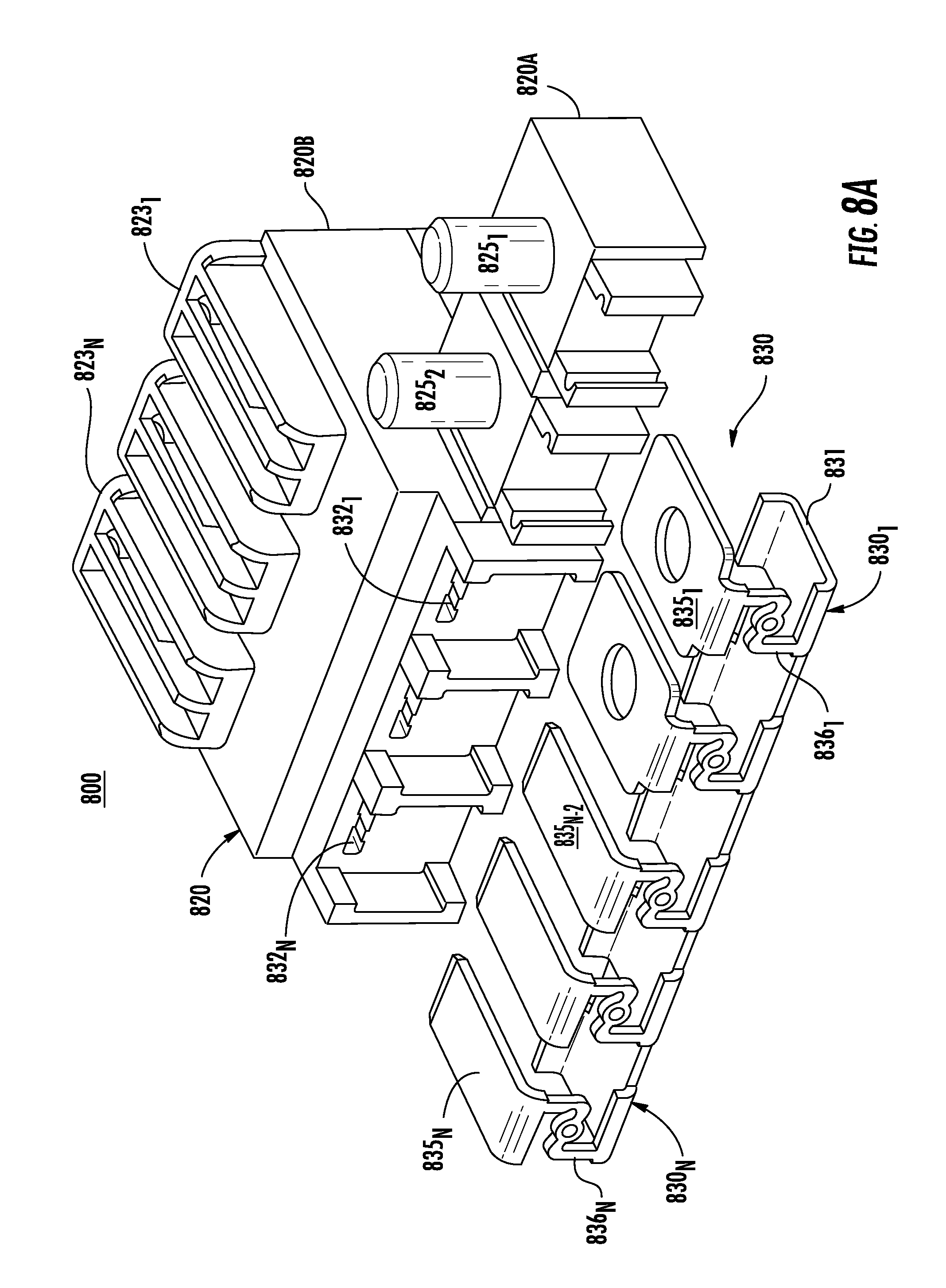
D00013
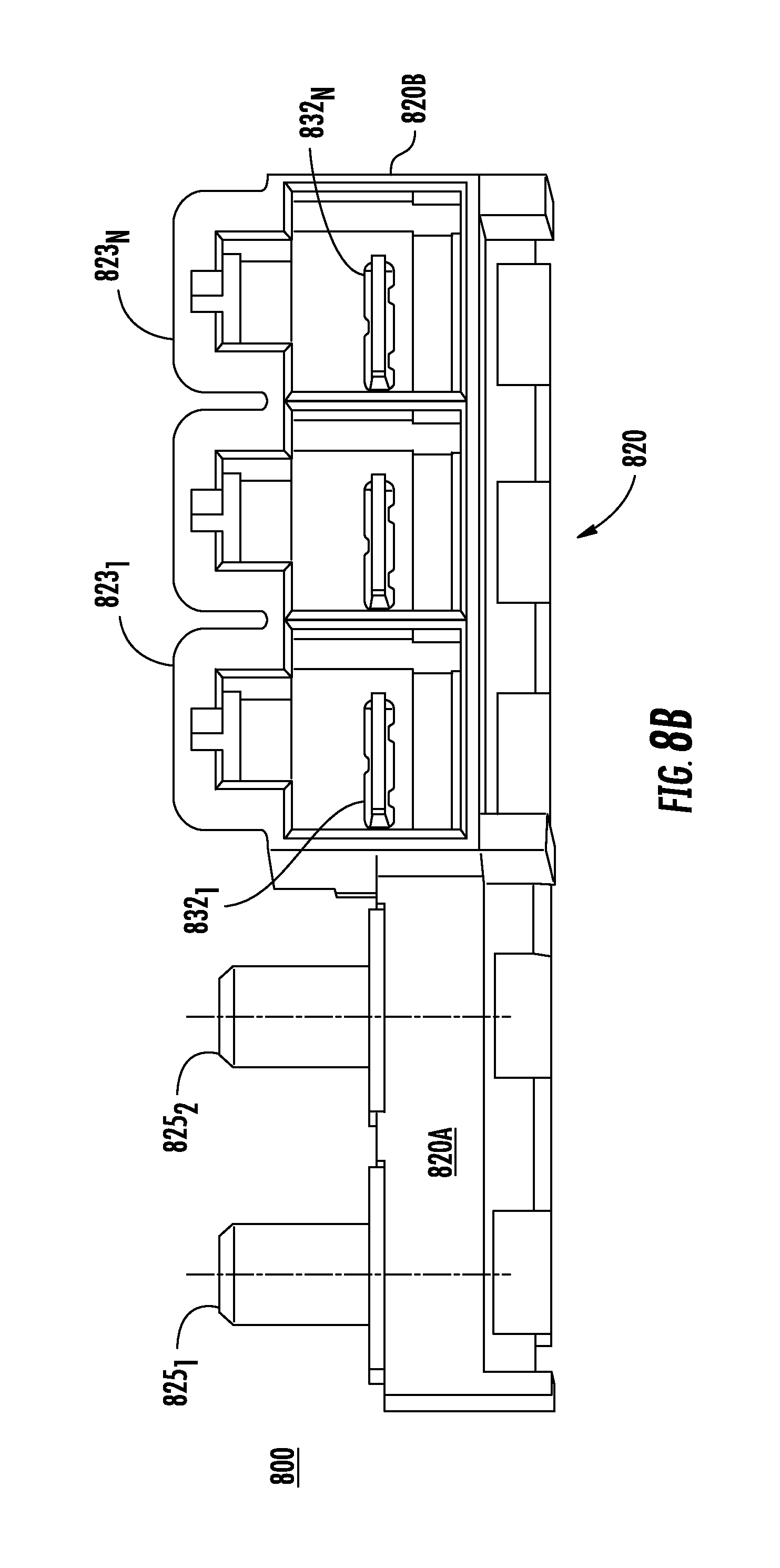
D00014
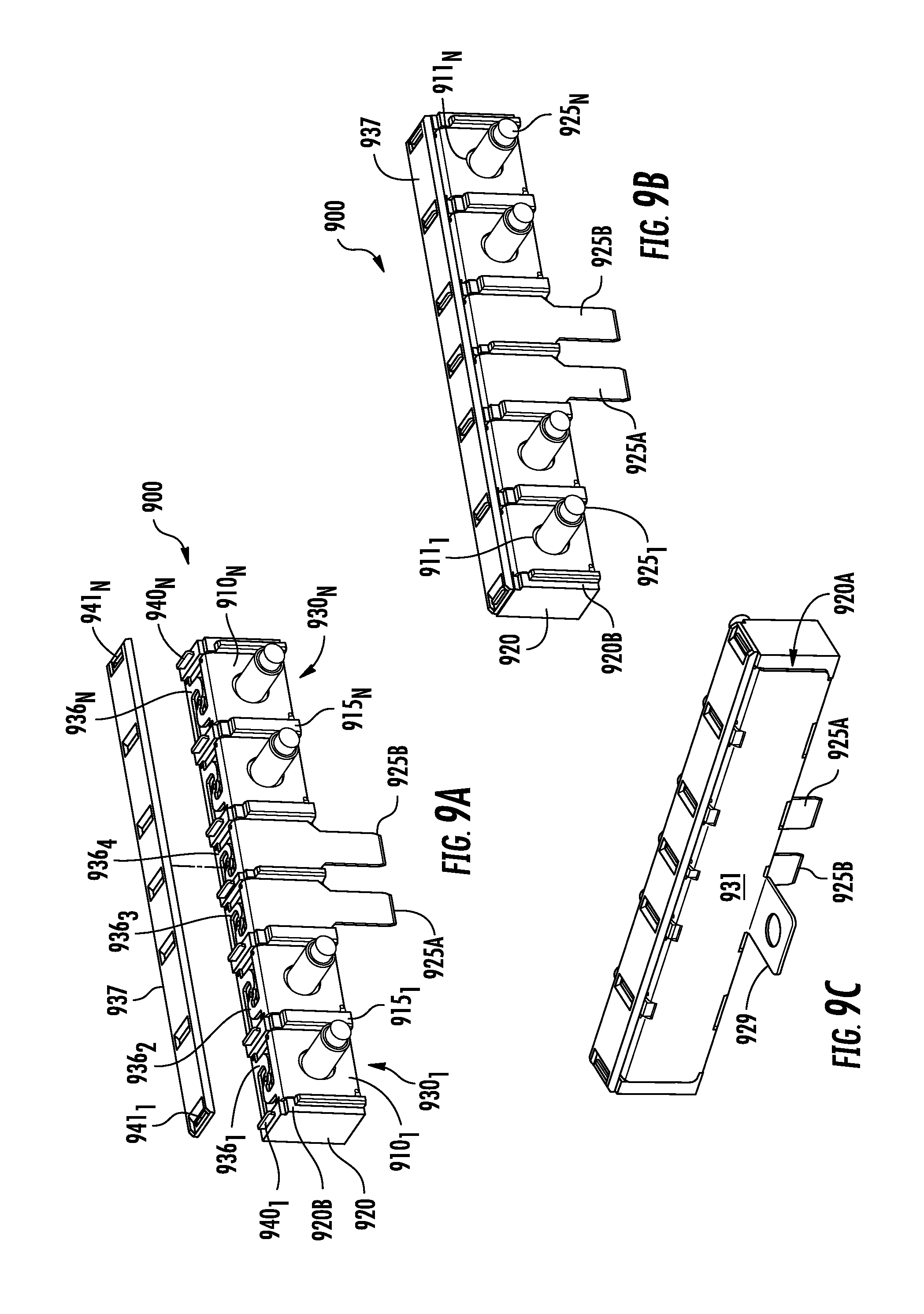
XML
uspto.report is an independent third-party trademark research tool that is not affiliated, endorsed, or sponsored by the United States Patent and Trademark Office (USPTO) or any other governmental organization. The information provided by uspto.report is based on publicly available data at the time of writing and is intended for informational purposes only.
While we strive to provide accurate and up-to-date information, we do not guarantee the accuracy, completeness, reliability, or suitability of the information displayed on this site. The use of this site is at your own risk. Any reliance you place on such information is therefore strictly at your own risk.
All official trademark data, including owner information, should be verified by visiting the official USPTO website at www.uspto.gov. This site is not intended to replace professional legal advice and should not be used as a substitute for consulting with a legal professional who is knowledgeable about trademark law.